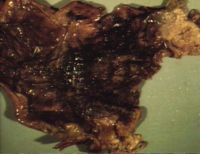Gastritis, Haemorrhagic
Clinical
- Usually only seen post mortem.
- Stomach full of thick tarry clots.
- Occasionally will vomit blood in life.
Pathology
Gross
- Wall of stomach is blacked and ulcerated.
- Red, thickened, necrotic, haemorrhagic mucosa.
Histologically
- Coagulative necrosis with fibrin, oedema, haemorrhage, and sometimes emphysema.
- May extend deep into submucosa/muscle.
Pathogenesis
- There are several causes of haemorrhagic gastritis
- Aspirin and non-steroidal anti inflammatory drug toxicity.
- Peracute / acute infections, e.g.
- Swine Fever
- Anthrax
- Leptospirosis in dogs (Leptospira icterohaemorrhagiae).
- Clostridial disease
- e.g. Braxy (Clostridium septicum)
- Affects older lambs or yearlings producing sudden death.
- Usually seen on sheep grazing on frosted grass so more common in colder areas.
- Bacterial exotoxin causes acute abomasitis.
- Pathology- At post mortem the stomach is grossly distended with partially clotted blood. The wall of the stomach is thickened,reddened and oedematous.
- Diagnosed by isolation of organism from the stomach wall.
- Is now usually vaccinated against (Heptovac 7 in 1 clostridial vaccine).
- e.g. Braxy (Clostridium septicum)
- Anticoagulant Rodenticide Toxicity.
